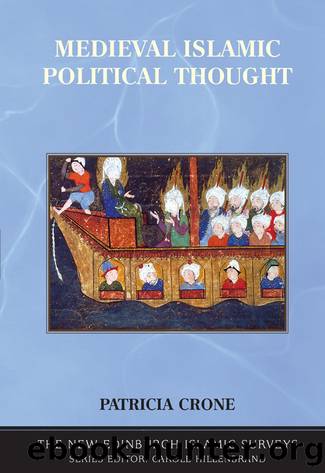Medieval Islamic Political Thought by Patricia Crone

Author:Patricia Crone
Language: eng
Format: epub
Publisher: Edinburgh University Press
1. The ImÄmÄ« imam was in hiding; the ZaydÄ« imam obtains his position by making a daÊ¿wa and khurÅ«j, not by being enthroned by others.
2. Cf. Ibn al-AthÄ«r, KÄmil, viii, 452f. (yr 334).
3. They had no religious motive (bÄÊ¿ith dÄ«nÄ«) to respect them, as Ibn al-AthÄ«r points out, ibid.
4. HamdÄnÄ«, Takmila, 211.
5. Ibish, Al-Baqillani, 45.
6. Busse, Chalif und Grosskönig, 420ff. and âThe Revival of Persian Kingshipâ.
7. Aḥsan, 131.2.
8. ÄthÄr, 132 = 129. They compare the caliph with the Jewish exilarch.
9. Above, 133.
10. Bosworth, Ghaznavids, 46.
11. Makdisi, âThe Marriage of Ṭughril Begâ and âLes rapports entre calife et sulá¹Ã¢nâ; Bosworth, âPolitical and Dynastic Historyâ, 101.
12. GhiyÄth, §§492ff., esp. 496, 499f.; cf. Nagel, Festung, 278f.
13. Below, note 93.
14. Pace Gibb (âAl-Mawardiâs Theoryâ, in his Studies, 151). The chapters on imÄma that one does find in fiqh works are about prayer leadership, not the âgreat imamateâ.
15. The idea was first proposed by Gibb, âAl-Mawardiâs Theoryâ, 152f.
16. Though the original work is normally assumed to be MÄwardÄ«âs, rightly in my view, the problem awaits systematic treatment (cf. Little, âA New Look at al-AḥkÄm al-Sulá¹Äniyyaâ).
17. Cf. the list in Mikhail, Politics and Revelation, 59f.
18. GhiyÄth, §§209, 303, cf. also §45.
19. For beginners, there is a useful translation of the relevant section from BaghdÄdÄ«âs Uṣūl in Gibb, âConstitutional Organizationâ, 7ff. At a specialist level, see the richly documented study by DumayjÄ«, al-ImÄma al-Ê¿uáºmÄ.
20. Cf. Nagel, Rechtleitung und Kalifat, et passim.
21. Cf. Crone and Hinds, Godâs Caliph, 21, note 86.
22. Above, 139. Cf. JuwaynÄ«, GhiyÄth, §206: in his opinion it was lawful for the caliph to designate his son as successor in his opinion, but this could not be decisively proved for lack of precedent, for the imamate had turned into mulk after the first four (who only designated peers, not sons).
23. Cf. above, 69, notes 8â10.
24. The expression is JuwaynÄ«âs (GhiyÄth, §15). Similarly Ê¿Abd al-JabbÄr, MughnÄ«, xx/1, 51. For further attestations, see DumayjÄ«, al-ImÄma al-Ê¿uáºmÄ, 45f.
25. Ibn Qutayba, K. al-Ê¿arab, 374.6. Adherents of the rule were to find many more reasons for it, cf. the battery of proof-texts and arguments available to DumayjÄ«, who vigorously defends it (al-ImÄma al-Ê¿uáºmÄ, 265ff.).
26. DumayjÄ«, al-ImÄma al-Ê¿uáºmÄ, 275.
27. GhiyÄth, §§106â9, 438â9; cf. also his IrshÄd, 240 = 359; Hallaq, âCaliphs, Jurists and the SaljÅ«qs,â 38f.
28. Crone, âEthiopian Slaveâ, 63ff.; add SimnÄnÄ«, Rawá¸at, i, §40 (some aṣḥÄb al-ḥadÄ«th).
29. Al-QÄhir, al-MuttaqÄ«, and al-MustakfÄ«.
30. Sufficiently to be accepted as a witness in court (e.g. BaghdÄdÄ«, Uṣūl, 277; tr. Gibb, âConstitutional Organizationâ, 9).
31. DumayjÄ«, al-ImÄma al-Ê¿uáºmÄ, 248, with dissenting voices at p. 250.
32. SimnÄnÄ«, Rawá¸a, i, §35. For the MuÊ¿tazilite view of the imam as a teacher, see above, 66, note 6; for the MuÊ¿tazilite who taught him kalÄm, see below, note 97.
33. For a concrete example, see NasawÄ«, SÄ«ra, 52, where the KhwÄrizmshÄh accuses the Caliph al-NÄá¹£ir of keeping members of the Ê¿AbbÄsid family in jail for so long that they were procreating there: the response is that if the caliphâs ijtihÄd led him to conclude that the incarceration of some would benefit all, then their incarceration was justified.
Download
This site does not store any files on its server. We only index and link to content provided by other sites. Please contact the content providers to delete copyright contents if any and email us, we'll remove relevant links or contents immediately.
Phoenicians among Others: Why Migrants Mattered in the Ancient Mediterranean by Denise Demetriou(584)
Verus Israel: Study of the Relations Between Christians and Jews in the Roman Empire, AD 135-425 by Marcel Simon(582)
Caesar Rules: The Emperor in the Changing Roman World (c. 50 BC â AD 565) by Olivier Hekster(565)
american english file 1 student book 3rd edition by Unknown(551)
Basic japanese A grammar and workbook by Unknown(514)
Europe, Strategy and Armed Forces by Sven Biscop Jo Coelmont(509)
Banned in the U.S.A. : A Reference Guide to Book Censorship in Schools and Public Libraries by Herbert N. Foerstel(474)
Give Me Liberty, Seventh Edition by Foner Eric & DuVal Kathleen & McGirr Lisa(472)
The Roman World 44 BC-AD 180 by Martin Goodman(466)
Reading Colonial Japan by Mason Michele;Lee Helen;(461)
DS001-THE MAN OF BRONZE by J.R.A(455)
The Dangerous Life and Ideas of Diogenes the Cynic by Jean-Manuel Roubineau(446)
Introducing Christian Ethics by Samuel Wells and Ben Quash with Rebekah Eklund(443)
Imperial Rome AD 193 - 284 by Ando Clifford(438)
The Oxford History of World War II by Richard Overy(437)
Literary Mathematics by Michael Gavin;(402)
Catiline by Henrik Ibsen--Delphi Classics (Illustrated) by Henrik Ibsen(397)
Language Hacking Mandarin by Benny Lewis & Dr. Licheng Gu(392)
How to Reach the 9.0 in IELTS Academic Reading by IELTS Medical(364)
